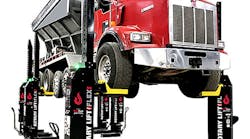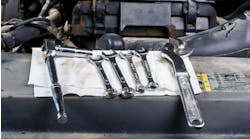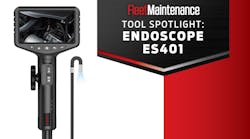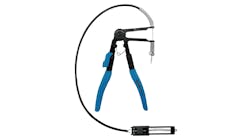The Review
If you want to improve on your shop’s efficiency and save time on repairs, reviewer Kevin Cromley, owner of Cromley Truck and Trailer Repair in Milton, Pennsylvania, recommends adding Rotary Lift’s Flex Max to your shop.
“It increased our efficiency more than I could have expected,” he says.
Cromley and his employees were fortunate enough to have their tool dealer, Turner Hydraulics, give them a demo of the lift, but Cromley says the lift’s simplicity makes it so anyone can use it.
“[The Flex Max lift is] very easy to set-up and use. It’s all self-explanatory [with] your codes on the side of the box,” Cromley says. Everybody in his shop is able to operate the lifts without the use of the remote and lift manuals that came with them.
In the shop, they use the lifts to perform oil pan service, suspension work, transmission work, and rear-end work. Cromley says he didn’t buy any accessories or adapters for different vehicle types because he bought the Flex Max lifts for service jobs.
“It works on everything we do. We work on semi-trucks, straight trucks, buses … [and] it’s nice to have that capability to lift almost 90,000 lbs,” he says.
Without the lifts, Cromley’s shop wouldn’t be able to do many jobs because, “these new trucks have so much flaring on them that you can’t even get under them,” he says. When looking into buying the Flex Max lifts, Cromley considered many different lift options and alternatives to lifts such as a pit, which was quickly ruled out due to the increase in insurance rates, and a ramp, which is not nearly as efficient as having lifts.
When considering specific features, such as corded vs. cordless, Cromley chose cordless. The Flex Max lift’s portability is one of his favorite features.
“We can move them anywhere in the shop to run multiple jobs at one time while we’re waiting on parts, [which] cuts down on service times on trucks,” he says.
Lifting and lowering a vehicle only takes around two or three minutes after you turn the lifts on.
“We shut ours off when we’re using them, that way we’re not draining the batteries down. A lot of times when we’re doing a long job, we just lock them and leave [the truck] set on the lifts,” Cromley explains.
Overall, Cromley is very pleased with the Flex Max lifts. He’s even considering buying a second set before the end of the year.
“I look at it this way, ” he says. “It’s an investment to the company when you buy equipment like this. They may not be the cheapest, but they are the best. They’re worth every penny.”




